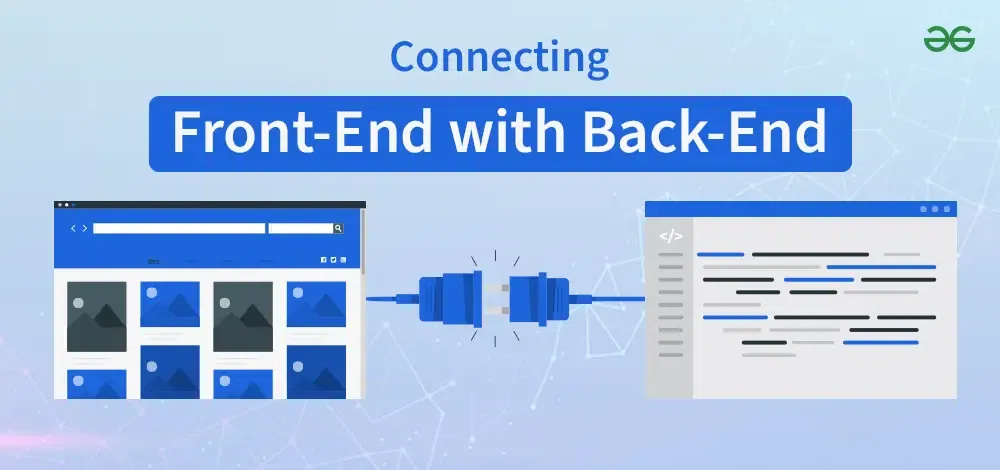
|
Every successful web application is built on the synergy between how frontend interacts with backend. Whether you’re building a dynamic website or a robust web application, the seamless connection between these two realms is predominant. In this guide, we’ll unravel the mysteries behind connecting the front end with back-end, shedding light on the process in a friendly format. But before directly jumping into that, let’s first discuss what these technologies actually are.
What is Frontend?Front-end development, also known as client-side is the art of making websites look good and work well for the people who use them. It is like painting a picture on a canvas, but the canvas is your web browser and the paint is code. A beautiful and useful website may be made essentially by knowing how to use different colors, forms, and designs. Languages like HTML, CSS, and JavaScript are used in front-end development to construct visually appealing and logically functional websites. The elements and structure of a website are defined by HTML, styled by CSS to produce an eye-catching visual, and integrated with JavaScript to add interaction and general functionality. Additionally, some frameworks like React, Vue, or Angular make development easier and faster by providing specific environment components. What is Backend?The back-end development, also known as server side is the process of making websites work and perform well for the users and other applications. It is like building the engine and the wiring of a car, but the car is your website and the engine and the wiring are code. To develop and maintain the server-side (backend) applications for your website, you must be very proficient in using a variety of languages, tools, and frameworks. In backend development use languages like Python, Java, Ruby, PHP, and JavaScript to build and manage server-side software. This phase manages requests from the frontend, interacts with databases and APIs, and then ensures data storage, security, and performance. Various Tools like PostgreSQL, MongoDB, Express.js, Django, Laravel, and Flask simplify and enhance backend development.
Now let’s discuss our main topic-How to connect backend with front end? Communication Methods1. RESTful APIs:REST (Representational State Transfer) is an architectural style for creating web services. This is the most popular approach. It generally uses HTTP request and response methods in order to exchange data in a normalize format. The backend exposes different endpoints for multiple functionalities, and then frontend makes calls to these endpoints in order to retrieve or manipulate data. Procedure:
Example Source Code:Frontend (JavaScript):Javascript
Backend (Node.js):Node
Backend (Node.js):Node
Frontend (HTML):HTML
4. GraphQLClient interactions with backend services are revolutionised by Facebook’s GraphQL query language for APIs. It gives developers a more effective, adaptable, and developer-friendly method of retrieving data by addressing many of the issues that our conventional RESTful APIs pose. Procedure:
Example Source Code:Frontend (JavaScript):Javascript
Backend (Node.js):Node
const { ApolloServer, gql } = require(‘apollo-server’);
// Define GraphQL schema using the gql tag type Post { type Query { // Define resolvers to handle GraphQL queries // Create an Apollo Server instance with the defined schema and resolvers // Start the server and listen for incoming GraphQL requests ConclusionConnecting the frontend and backend is like establishing a secure communication channel between two distinct domains: the user interface and server functionality. By grasping the unique roles of each side and adopting suitable communication methods, you pave the way for efficient data exchange and enhanced user interaction. Whether opting for RESTful APIs, leveraging WebSockets, implementing Server-Side Rendering, or embracing GraphQL, the crux lies in selecting the strategy aligned with your project’s specific needs. With careful planning and well-written code, you can create a strong communication channel that will provide your users with a smooth and effective experience. Explore these technical concepts thoroughly, perfect your strategy, and create solutions that will enhance your web applications to a whole new level! FAQs1. What is the significance of connecting the backend with the frontend in web development?
2. Can you explain RESTful APIs in simple terms?
3. What are the main ways the frontend and backend communicate in web development?
4. How WebSocket communication is different from traditional RESTful API communication?
|
Reffered: https://www.geeksforgeeks.org
| GBlog |
Type: | Geek |
Category: | Coding |
Sub Category: | Tutorial |
Uploaded by: | Admin |
Views: | 14 |